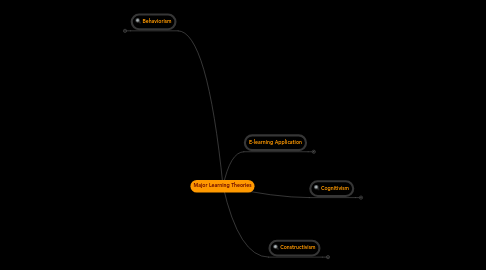
1. Behaviorism
1.1. Key concepts
1.1.1. Learner is passive, responding to environmental stimuli
1.1.2. Positive & negative reinforcement
1.1.3. Learning is defined as a change in learner's behavior
1.1.4. Focus on observable cause and effect relationship
1.1.4.1. No internal mental states
1.1.5. Knowledge is acquired from outside resources
1.1.5.1. Resulting from a finding process
1.1.6. Instruction is the process of providing knowledge
1.2. Theories
1.2.1. Ivan Pavlov
1.2.1.1. Conditioned Stimulus leads to conditioned response
1.2.2. J B Watson - stimulus-response
1.2.2.1. Behavior is observable and can be correlated with other observable events
1.2.3. Skinner's Theory of Radical Behaviorism
1.2.3.1. A behavior followed by a reinforcing stimulus results in an increased probability of that behavior occurring in the future.
1.2.3.2. To train learners in survival skills for self and society.
1.2.4. Key terms: classical conditioning, operant conditioning, stimulus-reponse, positivism
1.3. Methodologies
1.3.1. Teachers present and provide practice and feedback
1.3.2. Students remember and respond
1.3.3. Through lecture-based pedagogy as form of conditionuing
1.3.3.1. Students get good grades with correct answers to questions
2. Cognitivism
2.1. A response to behaviorism
2.1.1. opening the “black box” of the human mind is valuable
2.1.2. people are rational beings that require active participation in order to learn
2.1.3. actions are a consequence of thinking
2.1.4. focuses on the inner mental activities
2.1.5. Mental processes such as thinking, memory, knowing, and problem-solving need to be explored
2.2. Assumptions
2.2.1. prior knowledge plays an important role in learning
2.2.2. memory system as an active organized processor of information
2.3. Theories
2.3.1. Assimilation Theory (Ausubel)
2.3.1.1. Assimilating new concepts into existing concept frameworks
2.3.2. Cognitive Load Theory (Sweller)
2.3.2.1. Key terms: cognitive load, working memory, multimedia learning
2.3.3. Cognitive Theory of Multimedia Learning (Mayer)
2.3.3.1. Key terms: cognitive load, working memory, multimedia learning
2.3.4. Gestalt Psychology
2.3.5. Schema Theory (Anderson)
2.3.5.1. Schema grow and change as new information is acquired
2.3.5.2. Internal conflict occurs if learners are trying to assimilate schema which contradict their previous supposition
2.3.6. Social Learning Theory (Bandura) - bridge between Behaviorist and Cognitivist
2.3.6.1. Key terms: modeling, reciprocal determinism
2.3.7. Attribution Theory (Weiner)
2.3.7.1. Key terms: locus of control, stability, controllability
2.3.8. Information Processing Theory
2.3.8.1. Cognitive processes
2.4. Learning activities
2.4.1. Information seeking
2.4.2. Information presentation
2.4.3. Knowledge organization
2.4.4. Knowledge integration
2.5. Teacher's roles
2.5.1. Using cognitive tools to stimulate students thinking the validity, applicability and reliability for certain information
2.5.2. Developing students high order thinking skill which supports constructivist pedagogy
3. Constructivism
3.1. Key Concept
3.1.1. Individuals construct their knowledge through interaction rather than repetition
3.1.2. social context of learning is emphasized
3.1.3. Authenic learning
3.2. Constructivist theory of learning
3.2.1. Congnitive Constructivist Theory (Jean Piaget)
3.2.2. Social Constructivist Theory (Lev Vygotsky)
3.2.3. Bruner's theory on constructivism
3.3. Learning activities
3.3.1. Problem-based
3.3.2. Inquiry-based
3.3.3. Collaboration learning, such as discussion, experience sharing, etc.
3.3.4. Emphasis on the actual use in real situation instead of following list of rules
3.4. Teachers' roles
3.4.1. facilitators
3.4.2. challenge the learners to think and question
4. E-learning Application
4.1. Associative Perspective
4.1.1. Content delivery + interactivity linked directly to assessment and feedback
4.1.2. e.g. Merrill's instructional design
4.2. Cognitive Perspective
4.2.1. Simulated worlds, access to resources and expertise to develop more engaging active, authentic learning environment, etc.
4.2.2. e.g. Kolb's learning cycle
4.3. Situative Perspective
4.3.1. Adaptation in response to both discursive and active feedback; emphasis on social learning & communication/collaboration, etc.
4.3.2. Emphasis on social learning & communication/collaboration
4.3.3. e.g. Wenger’s Community of Practice
